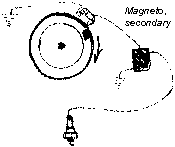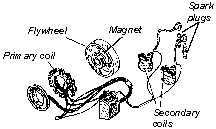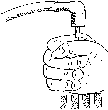
|
Almost everyone in Alaska has been stuck one time or another because
of “bad plugs.” Spark plugs are so important that airplanes
have two spark plugs in each cylinder, each fed by a different magneto.
Every engine that is fueled by gasoline has spark plugs, whether
it is a four wheeler, a chainsaw, or an old-time gasoline washing
machine. In a diesel engine the compression is so great that heat
generated by compression ignites the fuel.
Healthy spark plugs can make the difference between riding home
or walking, boating home or drifting.
|
|
Standards
A 6, 9,
15
B 3
D 1, 3
|
|
Concepts
Forms
of energy
Surface area
|
|
How Spark Plugs Work
 The
simple explanation is: The
simple explanation is:
- The magneto generates electric current in the primary coil.
- The secondary coil increases the voltage of that current. (Voltage
is like pressure that is behind elecricity as it travels thorugh
a wire. High voltage is like high pressure. Low voltage is like
low pressure.)
- The spark plug sparks, igniting the fuel.
- The fuel burns.
- The gasses expand, driving the piston.
- Work is done.
Generating Electricity in the Magneto
There is a permanent magnet on the spinning flywheel. When it
spins past the primary coil of wire, a current is generated which
passes down the wire under pressure towards the secondary coil.
The energy of motion is changed to electrical energy.
 Unfortunately,
at this point, even though there are enough electrons traveling
down the wire, they are not at high enough voltage1 to cause the
spark plug to spark. Unfortunately,
at this point, even though there are enough electrons traveling
down the wire, they are not at high enough voltage1 to cause the
spark plug to spark.
The electrons from the magneto pass through the secondary coil.
Fewer electrons come out of the secondary coil but they come out
with more voltage (pressure). These electrons arrive at the spark
plug just in time to ignite the fuel and air mixture. The voltage
going into the secondary coil might be as low as 50 volts, coming
out as high as 15,000 volts,
The Spark Ignites Fuel and air Mixture
In the cylinder, the piston has just come to the top of it’s
stroke. All of the air and gasoline droplets have been compressed
very close together to burn more efficiently.
Zap! The spark plug sparks. The first droplets of gasoline are
ignited by the heat of the spark. They ignite the ones next to them,
and in a chain reaction, they ignite the ones next to them. The
expanding gasses that result from the ignition of the gasoline forcefully
drive the piston downward.
Ignition Too Early. If the spark plug ignites the fuel before
the piston gets to the top of the stroke, the piston will be forced
backwards causing great stress on the engine.
Perfect Timing. In reality, the spark plug ignites the fuel a
few degrees before TDC (top dead center). It takes a fraction of
a second to ignite the fuel. In that very brief time, the piston
is at TDC and very efficient ignition takes place, burning the fuel
thoroughly all the way down the cylinder.
Ignition Too Late. If the spark plug ignites the fuel after the
piston is at the top, combustion will be late and all the fuel will
not burn before the piston gets to the bottom. The unburned fuel
will be pushed out of the cylinder.
Different fuels (marine gas, aviation gas, 100/130) burn at different
rates. This is why timing must be changed when fuel is changed.
Some fuels require more advance spark than others. It is like the
difference between pistol and rifle powder in firearms. Some powders
burn faster than others.
|
|

too early
correct
too late
|
| |
High Voltage
Air is not a good conductor of electricity. In the atmosphere,
a spark of 12,000 volts can jump a gap of .025”. Under pressure,
like in a cylinder, it is harder for the spark to jump the gap.
The pressure inside the cylinder of a two-cycle engine, like a chainsaw,
outboard, and simple snowmachine, is about seven times greater than
our atmosphere.
A spark plug that can spark in the open air may not be sparking
at all in the cylinder. It took me three days to learn this as I
cranked and cranked on a motorcycle.
The strength of the spark is revealed in the color. A red or yellow
spark is weak and probably will not spark in the cylinder. A blue
or white spark is strong and has enough voltage to fight across
the spark plug gap even under pressure within the cylinder.
|
|


|
Reasons for Spark Plugs Not Igniting Fuel
There are two main reasons that a spark plug will not fire well
if the voltage is present for a good spark.
- The gap is not set properly.
- There is carbon on the plug, shorting it out.
The Gap
If the gap on the spark plug is too close, there isn’t enough
spark exposed to the fuel/air mixture. The result will be a slow
rate of burn. This doesn’t sound important, but when there
are 100 ignitions a second, time is important.
If the gap on the spark plug is too big, the voltage may not be
strong enough to force the spark across the large gap. The resistance
is too great.
When the gap in the plug is correct, the strongest possible spark
is exposed to the largest surface of fuel/air mixture.
 Carbon
on the plug Carbon
on the plug
Carbon is formed when fuel isn’t completely burned. Carbon
is a good conductor of electricity. The brushes on electric motors
are made of carbon because it conducts electricity well.
If there is carbon on the side of the center post in the spark
plug it will take the easiest path, traveling through the carbon,
not sparking across the gap as we desire.
|
|

Dirty
spark plug
|
Troubleshooting
When an engine will not start, spark plugs often tell the story.
- If the plugs are a golden brown, they have been burning well
at the proper temperature.
- If the plugs are damp with gas, the fuel is present, but was
not ignited, there are spark problems.
- If the plugs are dry, there is no fuel to ignite, indicating
fuel problems.
- If the plugs are black, there are several possible reasons:
- The fuel mixture is too rich, or
- The spark is too weak to cause complete combustion.
- The wrong kind of two-cycle oil could be causing the problem.
When snowmachines first became popular in the late sixties
and early seventies, we had terrible problems because we used
outboard motor oil. It didn’t burn completely in the
colder winter temperatures.
- Too much oil in the fuel mixture (two-cycle engines). Some
engines call for a 20:1 mixture, others 50:1, and yet others
100:1. While too much oil will cause carbon problems in the
engine, not enough oil will destroy it! It is far better to
err by putting too much oil.
- The plugs are too “cold” for the engine. Hotter
plugs are hotter during operation. Colder plugs are colder
during operation. If a plug is black, perhaps the engine needs
a hotter plug that will retain more heat to burn off the carbon.
If a plug is scorched white, it has run too hot and the operator
should use a colder plug that gets rid of more heat. This
is very important with air-cooled engines. We run snowmachines
in temperature differences of over 80°. The machine’s
ability to retain and get rid of heat is drastically changed
during those conditions.
If the plug is not retaining enough heat, it will carbon. If it
is retaining too much heat, the cylinder could get too hot and burn
a hole in the piston. It is necessary to use colder plugs in warm
weather, and a hotter plug in colder weather.
If the plugs have white spots on them, it could indicate water
in the fuel.
If a plug is black with carbon and won’t fire, it can be
heated red hot in a Coleman or propane stove to burn the carbon
off. This will make the plug usable for a short time. Some people
sandblast plugs to remove carbon. This does get the carbon off,
but leaves a rough surface which quickly collect more carbon.
What could weaken the voltage to the spark plug?
- Dirty or worn magneto coil
- Improper distance between the magnet on the flywheel and the
magneto coil
- Broken or dirty wire connections
- from the magneto to secondary coil,
- from the secondary coil to the spark plug, or
- from the coil to the ground.
- Secondary coil shorting out inside.
- Dirty or cracked spark plug.
All gasoline engines use spark plugs. The system that generates
the spark is very simple and uses simple electrical principles.
A little attention and understanding will prevent or solve a lifetime
of mechanical problems.
|
| |
Activities
- Collect as many different kinds of spark plugs as you can find
in the village. How many different kinds do you find? How many
different companies are represented by the plugs? What differences
do you notice among them? How many different kinds of engines
do these plugs represent?
- Compare the length of the plugs, the length exposed within
the cylinder, the length of the threads, and the diameters. Why
do you think there are such differences? Can you find some plugs
that are golden brown, some black, and some that burned too hot?
(You may not, as the golden and white ones might be still in machines.)
- What are the differences in the identification numbers of hot
and cold plugs from the same manufacturer? If you can’t tell
by looking, a manual will tell the difference.
- Find old flywheels. Test the magnets for strength. Are they
strong or weak magnets?
- Get an old and a new spark plug of the same kind. Put the plug
wire of an engine (chainsaw is easiest) on each plug. Hold the
base of the plug against the cylinder of the engine, and crank
the engine over. Do you see a difference in the color of spark
in the new and old plug? (It is hard to see the spark in a bright
location.)
- Find a plug that will not fire in the above manner because
of carbon and dirt. Carefully clean the center post with a hairpin,
or other slim object. Can you clean it well enough to give a hot
blue or white spark?
- Close the gap on an old plug, and test it against the cylinder.
Did the color of the spark change when the gap was made smaller?
- Look up the recommended spark plug gap for three or four different
engines. The recommended gap should be in the manual for the machine.
Pick some high and some low compression engines. Why do you think
there are some differences in the recommended gaps?
- Find out about sandblasting spark plugs. Ask how long a sandblasted
plug will stay clean and why.
- Put the end of a fouled spark plug in the flame of a propane
or Coleman stove until it turns red hot. Carefully let it cool.
Test the spark before and after this. What difference do you see
in the spark? Why do you think this is so?
- Find a coil that people say is bad. Is there anything visible
to indicate that it doesn’t work well?

- On a working engine, pull the wire that goes from the magneto
to the coil. While holding the wire, ground your hand against
the cylinder and pull the starter rope. Put that wire back and
pull the wire from the spark plug. Put a screwdriver handle up
the spark plug cap and again ground your hand against the cylinder.
Pull the starter rope again. Do it slowly! Can you feel the difference
in voltage? (You should!) This will be uncomfortable, but shouldn’t
hurt unless you pull very fast.
- Ask around the village to see if anyone knows the difference
between a generator and an alternator. What is the difference?
- Draw a cylinder whose timing is too advanced. Draw one whose
timing is too slow. Look in an owner’s manual of a four-cycle
engine and find how many degrees before top dead center (BTDC)
the timing should be set.
|
| |
Student Response
- Make a simple drawing of the parts of the spark system of an
outboard motor from magneto to spark plug.
- Where is the electricity generated in an engine?
- Where is the voltage increased?
- What does the spark plug do in an engine?
- Draw and label three cylinders, one firing too soon, one firing
too late, and another firing at the proper time.
- Explain why a spark might jump the gap in open air, and not
in the cylinder.
- What colors indicate the hottest sparks?
- What colors indicate the weakest sparks?
- What two things could keep a spark plug from firing well?
- List five things that could make the spark plug black with
carbon?
- Draw a picture showing how a dirty plug allows the spark to
ground out, not jumping the gap.
- What kind of plug should be used in an air-cooled engine during
cold weather? Why?
- Why would an outboard be able to use one type of plug all the
time, and a snowmachine need different plugs in different seasons?
- List five things that could cause the voltage to a spark plug
to be weak.
|
| |
Math
- The voltage generated by a magneto is 50 volts. The coil increases
this to 15,000 volts. If the magneto is fixed so that it now generates
75 volts. How many volts will the coil produce?
|
|

 The
simple explanation is:
The
simple explanation is:
 Unfortunately,
at this point, even though there are enough electrons traveling
down the wire, they are not at high enough voltage1 to cause the
spark plug to spark.
Unfortunately,
at this point, even though there are enough electrons traveling
down the wire, they are not at high enough voltage1 to cause the
spark plug to spark.

 Carbon
on the plug
Carbon
on the plug 
